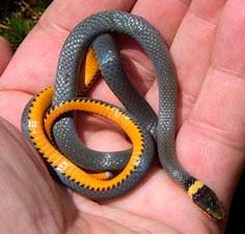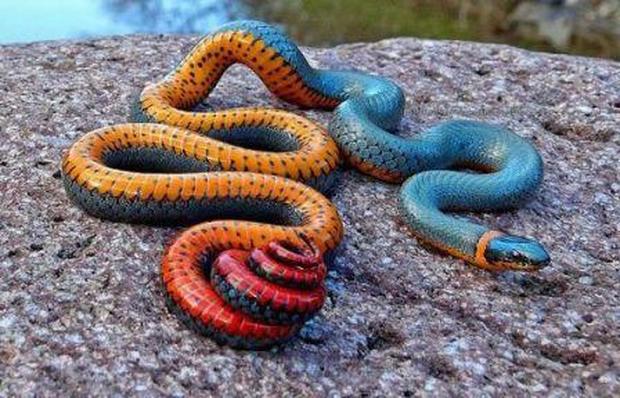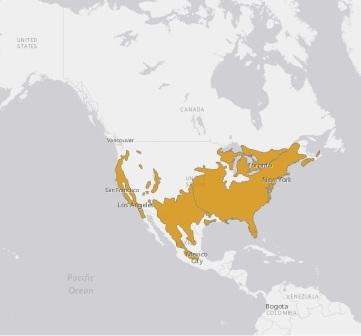Ringneck SnakeDiadophis punctatus |

Custom Search
|
|
The Ringneck snake (Diadophis punctatus) sometimes known as the Ring-necked snake is a mildly venomous but harmless colubrid snake found in southeastern Canada and throughout most of the United States southward into Central Mexico.
Ringneck snakes have one of the largest geographic ranges of any species of snake found in North America and several subspecies are recognized. The ringneck snakes inhabit woodlands, open hillsides, forests, brushy areas, grassland, chaparral, desert streams and riparian corridors in more arid regions. The preferred habitats have rocks, leaf litter, logs or other debris for the snakes to hide and are usually moist, at least seasonally. The ringneck snake is rather easy to identify owing to their vibrant underside coloration, that will start off as a bright yellow or orange at the head and becomes reddish at the tail. These brighter ventral colors also found on the chin and the upper labial scales. The species common name refers to the distinct yellow, orange or red band around the neck forming a ring. However, some specimens that lack distinctive neck ring. Their bright underside is covered with many black spots, hence the species specific epithet punctatus, which means perforated or punctured. These relatively small snakes typically reach about 20 inches (50 cm) but they can reach a maximum size up to 30 inches (75 cm). The ringneck snake has smooth scales and round pupils. They have quite a unique defensive posture when threatened they curl up their tails to expose their bright red or orangish underside. The ringneck snakes fall prey to a variety of other animals such as wild hogs, bullfrogs, eastern screech owls, striped skunks, nine-banded armadillos, Virginia opossums. They are also eaten by other snakes including the blue racer, northern coral snake or king snakes like the California kingsnake.
Subspecies / Etymology /Taxonomy
Their genus name "Diadophis" derives from the Greek words "diadem" meaning headband and "ophios" meaning serpent. The species name "punctatus" comes from the Latin "punctum" which translates as "small hole" or "spot". The ring-necked snake is the only species within the monotypic genus Diadophis. Today scientists usually recognize the following 14 subspecies of ringneck snake however not all herpetologists agree with this classification. Further phylogenetic and taxonomic studies are needed for this species to clarify all these issues. Southern ringneck snake (D. p. punctatus - Linnaeus, 1766) Northern ringneck snake (D. p. edwardsii - Merrem, 1820) Pacific ringneck snake (D. p. amabilis - Baird & Girard, 1853) Coral Bellied ringneck snake (D. p. pulchellus Baird & Girard, 1853) Regal ringneck snake (D. p. regalis - Baird & Girard, 1853) Prairie ringneck snake (D. p. arnyi - Kennicott, 1859) Mississippi ringneck snake (D. p. stictogenys Cope, 1860) San Bernardino ringneck snake (D. p. modestus - Bocourt, 1866) Dugès ringneck snake (D. p. dugesii - Villada, 1875) Northwestern ringneck snake (D. p. occidentalis - Blanchard, 1923) Monterey ringneck snake (D. p. vandenburghii Blanchard, 1923) San Diego ringneck snake (D. p. similis - Blanchard, 1923) Todos Santos Island ringneck snake (D. p. anthonyi - Van Denburgh & Slevin, 1942) Key ringneck snake (D. p. acricus - Paulson, 1966) Venom / Bite
Although the ring-necked snakes don't have a true venom gland they do have a similar structure called the Duvernoy's gland which produces a toxic saliva. So ring-necked snakes are indeed slightly venomous, their saliva contains a mild venom, which these type of snakes use to help them paralyze and subdue their prey. They inject their venom through the enlarged and channeled teeth located in their upper jaws, which in most subspecies are located at the rear of their mouth. The delivery system is not as evolved as that of "true" venomous snakes like the pit vipers, so they need to chew on the prey to inject the venom. Also, their venom evolved towards the snake's feeding needs they seldom show aggressiveness against larger predators indicating that the venom isn't used as a defensive measure. Their venom is considered totally innocuous to humans and therefore ringneck snakes are considered harmless. Diet / Feeding The ringneck snake feeds on a variety of animals such as lizards, frogs, slugs, tiny salamanders, bugs, earthworms and smaller snakes. These snakes are constrictors, wrapping their body around the prey and squeezing combined with a mild venom found in their saliva to subdue their prey. Reproduction Usually the ringneck snake mates in the spring, but some subspecies may mate in the fall. Females use pheromones secreted from their skin to attract males. To lay their eggs females usually choose locations with loose, aerated soils under a rock or in rotting logs, and it's common for this species to use communal nests. Females lay 3 to 10 eggs in early summer and after an incubation period of 5 to 8 weeks the eggs hatch in August or September. The eggs are white with contrasting yellow ends with approximately 1 inch in length and an elongated shape. The younglings measure about 3.5 to 5.5 inches (9 to 14 cm) in length and resemble adult snakes but have a darker dorsal coloration. After hatching the juvenile snakes are capable of fending for themselves without the need for any parental care. Both male and female snakes typically reach their reproductive maturity when they are about 3 years old. Conservation / Threats Ring- necked snakes are listed as "Least Concern" in view of their population size and a number of subpopulations together with its very large area of occupancy. The species is also found in several national parks and other protected areas. There are no major threats perceived to the species as a whole, however, some local populations have been extirpated or are declining because of habitat destruction.
|
Did You Know?
The titanoboa snake the biggest snake ever found it was 49 feet long, longer than a school bus! Scientific classification |
© 2014 Snake Facts About Us | Privacy Policy | Contact





